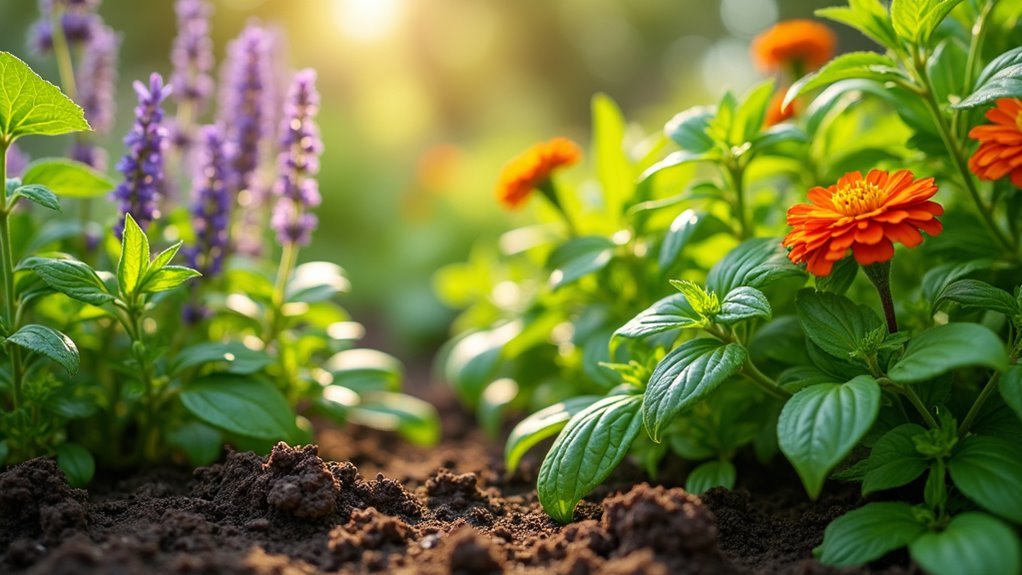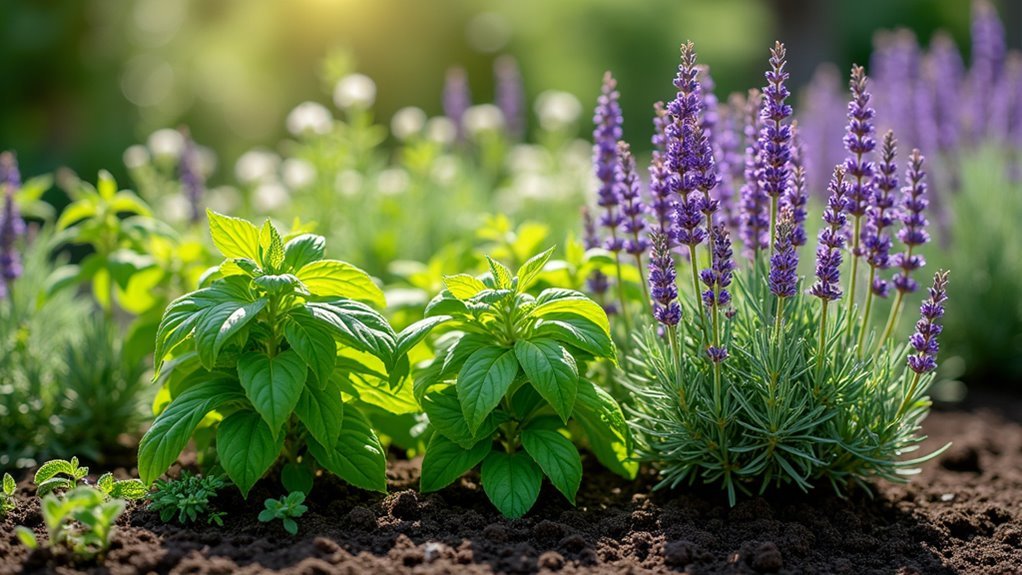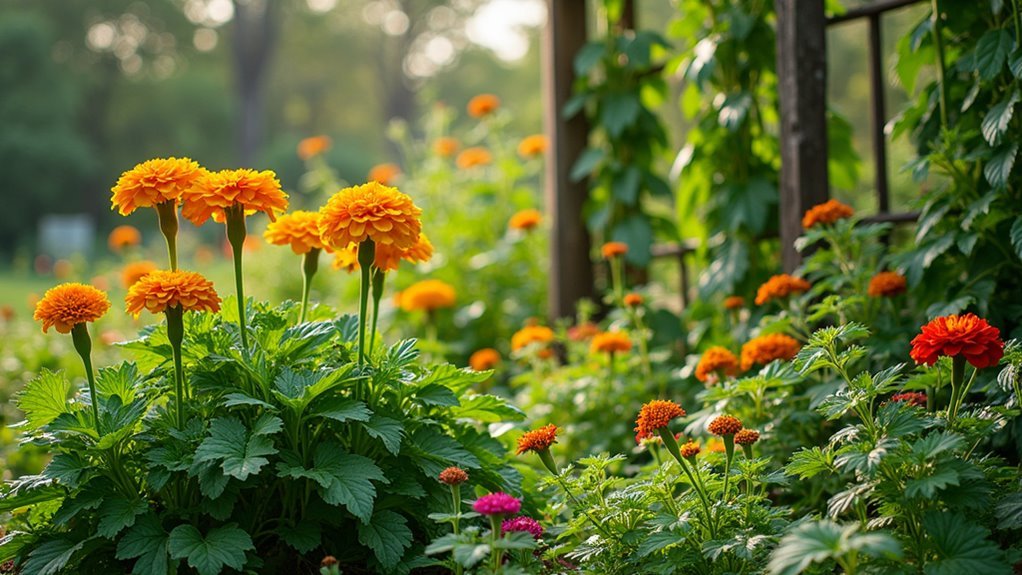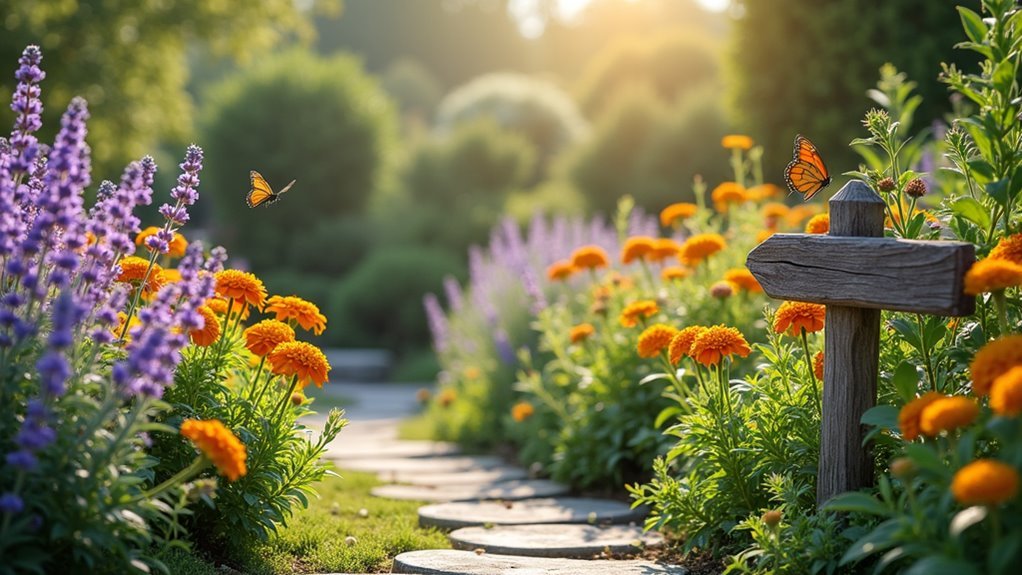You can design your garden to naturally repel unwanted pests by strategically planting fragrant herbs like lavender, basil, and rosemary near entryways and windows. Scatter marigolds throughout garden beds to deter aphids and nematodes, while positioning lemongrass in sunny spots for ideal citronella production against mosquitoes. Maintain proper spacing between plants and structures to improve airflow and reduce humidity that attracts insects. These strategic placement techniques will transform your outdoor space into an all-encompassing pest-deterrent system.
Understanding How Plants Naturally Repel Insects

When you’re planning your garden’s defense system, you’ll discover that nature has already equipped certain plants with powerful pest-deterring mechanisms.
These plants work through their natural fragrances and chemical compounds that insects find unpleasant or threatening. Your plant selection becomes essential when you want to repel pests effectively.
Lavender and basil emit strong scents that mosquitoes, flies, and moths actively avoid. Lemongrass produces citronella oil, creating a natural mosquito barrier.
Marigolds release compounds that deter nematodes and aphids while attracting beneficial insects that control harmful populations. Herbs like mint and rosemary create aromatic barriers through their intense fragrances.
Chrysanthemums contain pyrethrum, a powerful natural insecticide that repels mosquitoes, fleas, and various garden pests. Understanding these mechanisms helps you strategically position plants for maximum protection.
Strategic Plant Placement for Maximum Pest Deterrence
Placement alone can transform your garden from a pest haven into a natural fortress. Strategic plant placement maximizes your plants’ natural pest-repelling properties while creating multiple defensive layers throughout your outdoor space.
Position lavender near entryways where its fragrance creates an immediate barrier against mosquitoes, flies, and moths. Place basil close to windows and doors for dual-purpose protection—repelling insects while providing fresh herbs for your kitchen.
Scatter marigolds throughout your garden beds, as their potent scent deters mosquitoes and aphids while attracting beneficial insects that enhance pest control.
Incorporate lemongrass in sunny spots where its citronella oil works most effectively.
Don’t forget proper spacing between plants—improved airflow reduces humidity, creating an environment where pests struggle to thrive while supporting your repelling insects strategy.
Fragrant Herbs That Keep Unwanted Bugs Away

Because certain herbs naturally produce potent essential oils, you can harness their aromatic power to create a living pest control system.
These fragrant herbs offer dual benefits: they enhance your garden’s beauty while naturally deterring unwanted insects.
Basil’s strong scent repels mosquitoes, houseflies, ants, and tomato hornworms, making it perfect near vegetable gardens.
Lavender’s calming fragrance keeps mosquitoes, flies, and moths away while thriving in sunny, well-draining locations.
Mint’s oily aromatics deter cabbage moths, ants, mice, and fleas, though you’ll need to contain its vigorous growth.
Lemongrass mimics citronella’s mosquito-repelling properties and requires full sun with moist soil.
Rosemary protects against Japanese beetles and carrot flies while adding culinary value.
These fragrant herbs effectively repel pests without requiring chemical interventions.
Flowering Plants That Double as Pest Barriers
Beyond aromatic herbs, flowering plants offer an attractive solution that combines vibrant blooms with powerful pest-repelling properties. These beautiful additions to your garden don’t just provide visual appeal—they actively discourage pests while attracting beneficial insects.
| Plant | Repels | Attracts |
|---|---|---|
| Marigolds | Mosquitoes, aphids | Beneficial pollinators |
| Chrysanthemums | Ants, cockroaches, ticks | Pollinators |
| Nasturtiums | Whiteflies, squash bugs | Bees, butterflies |
| Lavender | Mosquitoes, flies, moths | Bees |
| Eucalyptus | Mosquitoes, flies | Beneficial insects |
You’ll find marigolds particularly effective with their strong scent that drives away multiple pest species. Chrysanthemums contain natural pyrethrum, making them excellent for deterring crawling insects. Plant nasturtiums near vulnerable crops, and position lavender near entryways for maximum protection. Eucalyptus leaves can even be harvested to create natural repellent sprays.
Companion Planting Techniques for Pest Control

When you strategically pair certain plants together, you’ll create natural partnerships that protect your garden from pests while promoting healthier growth.
Companion planting harnesses nature’s built-in defense systems to establish a balanced garden ecosystem.
By working with nature’s wisdom instead of against it, gardeners can create thriving ecosystems that protect and nourish themselves.
Here are three effective companion planting strategies:
- Plant basil near tomatoes to repel hornworms while enhancing tomato flavor through their symbiotic relationship.
- Use marigolds throughout vegetable gardens as their strong scent naturally deters nematodes and aphids from attacking nearby crops.
- Alternate pest-sensitive plants like lettuce with pest-resistant radishes to disrupt feeding patterns and create protective barriers.
Sweet Alyssum’s fragrant blooms attract beneficial insects like ladybugs, lacewings, and pollinators, establishing natural pest control while supporting garden health through increased pollination.
Creating Bug-Free Zones Around Your Home
While companion planting protects your garden beds, you’ll need additional strategies to establish pest-free zones immediately surrounding your home. Start by eliminating standing water sources to prevent mosquitos from breeding in stagnant pools. Position pest-repelling plants like lavender, basil, and marigolds near entryways and patios to create natural barriers against pest insects.
| Strategy | Action | Distance | Benefit |
|---|---|---|---|
| Plant Spacing | Maintain proper airflow | 2+ feet from structures | Reduces pest hiding spots |
| Water Management | Remove standing water | Throughout property | Prevents mosquito breeding |
| Pruning | Trim overhanging branches | Away from rooflines | Blocks rodent access points |
| Cleanup | Remove fallen debris | Regular maintenance | Eliminates pest attractants |
These combined approaches create effective defensive perimeters that keep unwanted visitors away from your home’s immediate vicinity.
Attracting Beneficial Insects to Combat Garden Pests
You can transform your garden into a natural pest control system by selecting plants that attract beneficial insects rather than relying solely on chemical treatments.
Strategic placement of pollinator-friendly flowers creates dedicated habitat areas where helpful predators like ladybugs, hoverflies, and lacewings will establish themselves.
These natural allies will actively hunt down aphids, nematodes, and other harmful pests while maintaining your garden’s ecological balance.
Beneficial Bug Plant Choices
One powerful strategy for natural pest control involves selecting plants that attract beneficial insects to your garden.
These helpful creatures naturally combat unwanted pests without requiring chemical interventions. You’ll want to choose flowering plants that provide nectar, pollen, and shelter for predatory insects.
Consider these top plant choices for attracting pest-controlling allies:
- Sweet alyssum – Draws pollinators, lacewings, and ladybugs that devour aphids and other harmful insects
- Yarrow – This perennial attracts hoverflies and predatory wasps that keep pest populations balanced
- Marigolds – Deter nematodes while attracting predatory insects that feed on common garden pests
Adding flower clusters like daisies and coneflowers creates habitats for beneficial insects.
A diverse landscape with mixed flowering plants greatly improves your chances of establishing natural pest control systems.
Creating Pollinator Habitat Areas
Beyond selecting individual beneficial plants, establishing dedicated pollinator habitat areas amplifies your garden’s natural pest control capabilities.
You’ll want to create flower clusters using marigolds and nasturtiums, which beautify your landscape while attracting beneficial insects that actively prey on garden pests.
Plant diverse flowering varieties like sweet alyssum and yarrow to draw ladybugs and lacewings that effectively control pest populations.
Incorporate aromatic herbs such as cilantro and dill, which serve dual purposes by attracting pollinators while deterring harmful pests through their strong scents.
Focus on maintaining native plant varieties that encourage predatory insects and birds, creating a balanced ecosystem that naturally reduces pest populations and promotes long-term garden health.
Natural Predator Encouragement Methods
While pollinator habitats form the foundation of natural pest control, specific techniques can dramatically increase beneficial insect populations in your garden.
You’ll attract powerful natural insect allies by strategically planting companion flowers and herbs that provide essential resources for predatory species.
Focus on these proven attraction methods:
- Plant sweet alyssum and yarrow to draw lacewings and ladybugs that actively hunt common pests.
- Include marigolds to deter nematodes while attracting carnivorous bugs that eliminate harmful insects.
- Grow dill and cilantro to produce nectar that feeds predatory insects throughout the growing season.
Create flower and herb clusters rather than scattered plantings.
This concentrated approach increases your garden’s appeal to beneficial insects, establishes sustainable pest management, and reduces your dependence on chemical interventions while maintaining natural ecosystem balance.
Proper Garden Maintenance to Eliminate Pest Habitats
Although strategic plant selection forms the foundation of pest control, maintaining your garden properly serves as the critical second line of defense against unwanted invaders.
You’ll need to eliminate conditions that attract pests by removing standing water from plant saucers and birdbaths, where mosquitoes breed rapidly. Clear fallen fruit and debris immediately—they’re magnets for various pests seeking food sources.
Store firewood at least 20 feet from your home to prevent rodent access.
Prune overhanging branches and dense shrubs to reduce moisture and shade that pests love. Maintain proper spacing between plants, keeping them two feet from your house. This creates better airflow while eliminating hiding spots where pests typically shelter and multiply.
Designing Plant Layouts That Disrupt Pest Breeding Cycles
Strategic plant placement disrupts pest reproduction patterns more effectively than random garden layouts, giving you a powerful tool to break infestation cycles before they establish.
Strategic garden design becomes your secret weapon against pest infestations by disrupting their natural breeding cycles through intentional plant placement.
You’ll want to implement spacing between plants of at least two feet from structures to enhance airflow and eliminate shadowy breeding spots pests prefer.
Effective companion planting techniques create natural pest deterrents:
- Mix pest-resistant and pest-sensitive varieties throughout your garden to confuse breeding cycles and prevent concentrated infestations.
- Position marigolds strategically next to vegetable crops to repel specific pests while maintaining ecosystem balance.
- Create herb borders using basil and rosemary around vulnerable plants to mask attractive scents that trigger reproductive behaviors.
This intentional design approach transforms your garden into an inhospitable environment for pest establishment.
Frequently Asked Questions
How Do You Deter Pests in Your Garden?
You’ll deter pests by planting lavender, basil, and marigolds, spacing plants properly for airflow, eliminating standing water, pruning regularly, and using companion planting to disrupt feeding patterns while attracting beneficial insects.
What Is the Best Deterrent for Garden Pests?
You’ll find the best deterrent combines multiple strategies: plant aromatic herbs like lavender and basil, eliminate standing water, introduce beneficial insects through diverse flowering plants, and maintain proper garden hygiene consistently.
What to Plant to Keep Bugs Away From the Garden?
You’ll want to plant lavender near entryways, basil by windows and doors, lemongrass for citronella oils, marigolds in vegetable gardens, and mint throughout your space to naturally repel various insects.
Which Companion Plant Repels Flies and Ants?
You’ll want to plant basil, mint, or chrysanthemums to repel both flies and ants. Basil’s particularly effective near entryways, while mint’s aromatic oils work well in borders, and chrysanthemums contain natural pyrethrum.
In Summary
You’ve now got the tools to transform your garden into a natural pest-fighting fortress. By strategically placing repellent plants, incorporating fragrant herbs, and maintaining proper garden hygiene, you’ll create an environment that unwanted pests simply can’t tolerate. Remember, it’s not just about keeping bugs away—you’re building a balanced ecosystem that works in your favor. Start implementing these techniques today, and you’ll soon enjoy a thriving, pest-free garden sanctuary.





Leave a Reply